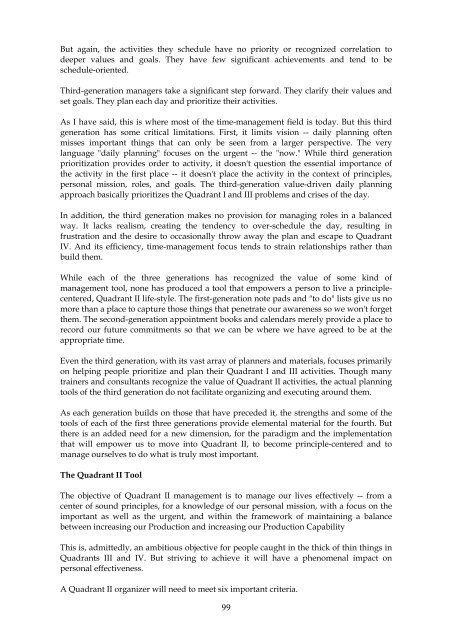Covey - The 7 habits of highly effective people
You also want an ePaper? Increase the reach of your titles
YUMPU automatically turns print PDFs into web optimized ePapers that Google loves.
But again, the activities they schedule have no priority or recognized correlation to<br />
deeper values and goals. <strong>The</strong>y have few significant achievements and tend to be<br />
schedule-oriented.<br />
Third-generation managers take a significant step forward. <strong>The</strong>y clarify their values and<br />
set goals. <strong>The</strong>y plan each day and prioritize their activities.<br />
As I have said, this is where most <strong>of</strong> the time-management field is today. But this third<br />
generation has some critical limitations. First, it limits vision -- daily planning <strong>of</strong>ten<br />
misses important things that can only be seen from a larger perspective. <strong>The</strong> very<br />
language "daily planning" focuses on the urgent -- the "now." While third generation<br />
prioritization provides order to activity, it doesn't question the essential importance <strong>of</strong><br />
the activity in the first place -- it doesn't place the activity in the context <strong>of</strong> principles,<br />
personal mission, roles, and goals. <strong>The</strong> third-generation value-driven daily planning<br />
approach basically prioritizes the Quadrant I and III problems and crises <strong>of</strong> the day.<br />
In addition, the third generation makes no provision for managing roles in a balanced<br />
way. It lacks realism, creating the tendency to over-schedule the day, resulting in<br />
frustration and the desire to occasionally throw away the plan and escape to Quadrant<br />
IV. And its efficiency, time-management focus tends to strain relationships rather than<br />
build them.<br />
While each <strong>of</strong> the three generations has recognized the value <strong>of</strong> some kind <strong>of</strong><br />
management tool, none has produced a tool that empowers a person to live a principlecentered,<br />
Quadrant II life-style. <strong>The</strong> first-generation note pads and "to do" lists give us no<br />
more than a place to capture those things that penetrate our awareness so we won't forget<br />
them. <strong>The</strong> second-generation appointment books and calendars merely provide a place to<br />
record our future commitments so that we can be where we have agreed to be at the<br />
appropriate time.<br />
Even the third generation, with its vast array <strong>of</strong> planners and materials, focuses primarily<br />
on helping <strong>people</strong> prioritize and plan their Quadrant I and III activities. Though many<br />
trainers and consultants recognize the value <strong>of</strong> Quadrant II activities, the actual planning<br />
tools <strong>of</strong> the third generation do not facilitate organizing and executing around them.<br />
As each generation builds on those that have preceded it, the strengths and some <strong>of</strong> the<br />
tools <strong>of</strong> each <strong>of</strong> the first three generations provide elemental material for the fourth. But<br />
there is an added need for a new dimension, for the paradigm and the implementation<br />
that will empower us to move into Quadrant II, to become principle-centered and to<br />
manage ourselves to do what is truly most important.<br />
<strong>The</strong> Quadrant II Tool<br />
<strong>The</strong> objective <strong>of</strong> Quadrant II management is to manage our lives <strong>effective</strong>ly -- from a<br />
center <strong>of</strong> sound principles, for a knowledge <strong>of</strong> our personal mission, with a focus on the<br />
important as well as the urgent, and within the framework <strong>of</strong> maintaining a balance<br />
between increasing our Production and increasing our Production Capability<br />
This is, admittedly, an ambitious objective for <strong>people</strong> caught in the thick <strong>of</strong> thin things in<br />
Quadrants III and IV. But striving to achieve it will have a phenomenal impact on<br />
personal <strong>effective</strong>ness.<br />
A Quadrant II organizer will need to meet six important criteria.<br />
99


